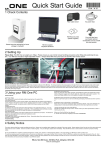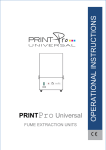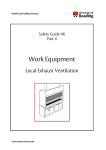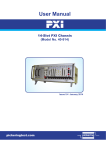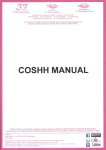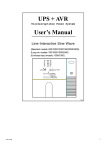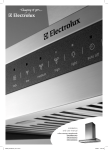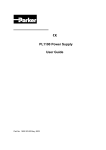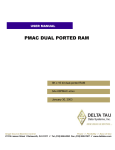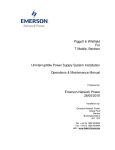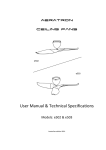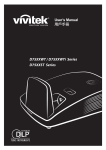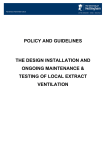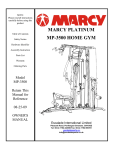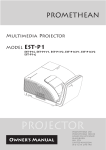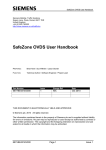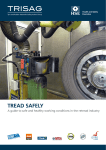Download Bofa - DS Range PrintPro User`s Manual
Transcript
OPERATIONAL INSTRUCTIONS RANGE FUME EXTRACTION UNITS 1 Version 1 July 2011 TABLE OF CONTENT SAFETY INSTRUCTIONS ..................................................................................................... 3 Symbols used ................................................................................................................ 3 Electrical safety............................................................................................................. 3 Dangers to eyes, breathing and skin ............................................................................ 3 Warning and Information Labels .................................................................................. 4 INSTALLATION ................................................................................................................. 5 Extractor Overview ....................................................................................................... 5 800 DS ........................................................................................................................... 5 Extractor Installation Procedure ................................................................................... 6 Optional Feature Considerations .................................................................................. 6 Filter blocked/System failure signal ................................................................ 6 Remote stop/start ........................................................................................... 7 Remote Stop/ Start Over-Ride ......................................................................... 7 Gas Filter Change LED (VOC monitoring) ........................................................ 8 Electrical supply connection ......................................................................................... 8 General Safety Requirements ....................................................................................... 8 OPERATION ..................................................................................................................... 9 Manual operation ......................................................................................................... 9 Closed Loop Auto Flow Control ...................................................................... 10 Setting the Airflow ......................................................................................... 10 MAINTENANCE .............................................................................................................. 11 Maintenance UK ......................................................................................................... 11 Maintenance General ................................................................................................. 11 Cleaning Unit .............................................................................................................. 11 Replacing Filters ......................................................................................................... 11 Filter replacement indication...................................................................................... 12 Pre filter Sponge replacement ....................................................................... 12 HEPA filter replacement ................................................................................ 13 GAS filter replacement................................................................................... 14 Consumable Spares .................................................................................................... 15 Maintenance Protocol ................................................................................................ 15 Fuses ........................................................................................................................... 16 Filter Disposal ............................................................................................................. 16 TROUBLE SHOOTING ...................................................................................................... 17 SYSTEM SPECIFICATIONS ................................................................................................ 18 Unit: Oracle DS ........................................................................................................... 18 Unit: 800 DS ................................................................................................................ 18 2 Version 1 July 2011 SAFETY INSTRUCTIONS Symbols used Danger Refers to an immediately impending danger. If the danger is not avoided, it could result in death or severe (crippling) injury. Please consult the manual where this symbol is displayed. Warning Refers to a possibly dangerous situation. If it is not avoided, it could result in death or severe injury. Please consult the manual where this symbol is displayed. Caution Refers to a possibly harmful situation. If it is not avoided, damage could be caused to the product or to something in its environment. Important Refers to handling tips and other particularly useful information. This does not signify a dangerous or harmful situation. Electrical safety The DS range of extraction units are designed to meet the safety requirements of the Low Voltage Directive 2006/95/EC (previously numbered 73/23/EEC) Warning During works with the pump/motor housing open, live, 230/115 volt components are accessible. Make sure that rules and regulations for work on live components are always observed. Important To reduce the risk of fire, electric shock or injury: 1. Always isolate the system from the mains power supply before removing the pump/motor panel. 2. Use only as described in the manual. 3. Connect to a properly grounded outlet. Dangers to eyes, breathing and skin Once used, the filters in the DS range of extraction units contain a mixture of particulates, some of which may be sub micron size. When the used filters are moved it may agitate some of this particulate, which could get into the breathing zone and eyes of the operative. Additionally, depending on the materials used, the particulate may be an irritant to the skin. Caution: When changing used filters always wear mask, safety glasses and gloves. Please note the media in the gas filter fitted in this unit is capable of adsorbing a wide range of organic compounds. However, it is the responsibility of the user to ensure it is suitable for the particular application it is being used on. 3 Version 1 July 2011 Warning and Information Labels Label/Symbol Position Pump / motor across panel inside door, central. Pump/motor access panel Inside door top corner Rear of unit above louvers Side of unit, next to cables 4 Version 1 July 2011 INSTALLATION Extractor Overview The DS range provides extraction and filtration of the fume generated by Dye |Sublimation. The units are of robust design and feature ease of use with minimal maintenance. The main components are shown in Fig. 1. Fig. 1 1. 2. 3. 4. 5. 6. 7. 8. 9. 10. 11. 12. Unit / Filter Condition Display – Auto Flow Control On / Off Switch Power Cable Signal / Interface Cable to Laser Door Latch Door Hinge Drain Valve Exhausted Air Outlet Motor Cooling Louvers Drainage Tray Hose Inlet Connections Filter Housing Cam Latch Oracle DS 2 4 1 3 6 9 5 8 7 12 11 10 800 DS 5 Version 1 July 2011 Extractor Installation Procedure Caution If this equipment is used in a manner not specified by the manufacturer, the protection provided by the equipment may be impaired. Read all instructions in this manual before using this extractor. 1. Move the unit to the location where it is going to be installed and remove the unit from its packaging. The unit should be installed in a well ventilated room. Caution Due to the weight involved the extractor unit should only be lifted using suitable lifting equipment and with regard to appropriate safety precautions. (See Appendix for product weight details). 2. Ensure that a 0.5m space is available around any louvered areas of the unit to ensure adequate air flow. Lock the two braked castors, if fitted. Caution Do not block or cover the cooling vents on the unit, as this severely restricts airflow and may cause damage to the unit. (This may be located on the base of the unit). Caution Under no circumstances should the exhaust outlet/s be covered as this will restrict the airflow and cause overheating. 3. Check filters are located in their correct position and carefully replace lid/close door. 4. Connect the extraction ducting between the extractor inlet and the fume capture device. Optional Feature Considerations 5. If fitted, the following features need to be considered when installing the unit: Important If the DS unit has an exhaust air outlet spigot fitted, the exhausted air can be routed outside of the building if required. It is important to keep any ducting used to do so to a minimum, in order to reduce back pressure within the system. Filter blocked/System failure signal With this option the extraction unit will have been fitted with a pressure transducer to monitor the condition of the filters and to indicate the extractor is running. In addition to controlling the LED‟s on the front of the unit, this signal is available via the green 6 Version 1 July 2011 and white cores of the control cable that exits the cabinet next to the power cable. The signal is a “volt free” contact, i.e. a closed circuit will exist between the green and white wires when the filter condition is good and the unit is running. This will change to an open circuit on filter blockage or system failure. This feature should only be used on control voltage circuits. The signal can be connected to the laser or alternatively to operate a beacon, siren or warning device. Open circuit condition of this circuit will not directly stop the extractor motor. Remote stop/start If this facility is installed it enables the extractor unit to be turned on and off by a signal from the laser. The red and black cores of the control cable need to be connected to a 5 – 24v dc supply, which when applied will start the unit and when switched off will stop the unit. However the mains power switch must be in the “on” position for the signal to be effective. (Unless 0V stop/start option was specified when ordered, for this connect the Red & Black cores together to start the extractor.) Fig 2 5-24V Remote Stop/ Start Over-Ride If fitted, remote operation can be overridden by using the override switch, which is mounted inside the unit (see fig. 3). Fig 3 7 Version 1 July 2011 Gas Filter Change LED (VOC monitoring) Units equipped with a VOC sensor detect the level of Volatile Organic Compounds inthe exhausted air. If their presence exceeds a preset level the Alarm LED on the front panel will illuminate. This indicates that the gas portion of the combined filter is saturated and the filter needs replacing. See fig 10. The Maintenance section describes the filter change procedure. Electrical supply connection 6. Check the integrity of the electrical power cable. Connect the power cable to an isolated electrical supply. The mains socket outlet should be installed near the equipment and be easily accessible. The cable run to the machine should be arranged so as not to create a trip hazard. Caution: Check that the mains input at the isolated supply is the same as the voltage Supply detail on the Serial Number label (115 - 230v 50/60Hz) before plugging the extractor unit in. General Safety Requirements The mains socket outlet should be installed near the equipment and be easily accessible. Caution Do not block or cover the cooling vents on the unit, as this severely restricts airflow and may cause damage to the unit. (This may be located on the base of the unit). Caution This unit is over 18Kgs in weight and should only be lifted with suitable lifting equipment. Caution If this equipment is used in a manner not specified by the manufacturer, the protection provided by the equipment may be impaired. Read all instructions in this manual before using this extractor. Warning Mains voltage. Dangerous voltages exist in this equipment. Ensure all covers are fitted before operating this equipment. The unit is now ready for use. 8 Version 1 July 2011 OPERATION Manual operation Stainless steel DS units are turned on by depressing the green button on the front of the extractor and turned off by depressing the red button. See fig 4. Fig 4 Stainless Steel Units Note: In order to help ensure long term reliability of the fan unit, it is recommended that a 90 second delay period (minimum) is observed between stopping and restarting the extractor to prevent possible damage to electronic components within the fan. Filter condition and System failure signal - indicators The LED‟s on the front panel (see table and fig 5 below) indicate the following conditions LED’S SHOWING INDICATES Green Only Unit is running - Filters are usable Green & Amber Pre or Combined Filter 75% blocked Green, Amber & Red Pre or Combined Filter Blocked and in need of replacing Green, Amber & Red flashing Fault with extractor. This condition may occur for a few seconds on start up Red Alarm Light Only used with optional extra Gas Filter Change LED Filter change procedures are explained in Section 5 „Maintenance‟. 9 Version 1 July 2011 Fig 5 Closed Loop Auto Flow Control With this fitted the unit features closed loop automatic flow control. This enables you to set the required airflow rate. When filters start to block, the blowers in the extractor will increase in speed compensating for any loss in performance. The extractor must be fully installed, with all pipe work connected before setting the airflow. Setting the Airflow To set the airflow on your extractor, hold down the Up (+) and Down (-) arrows on the front panel for 5 seconds. (See fig 8) The green LED will now start to flash, indicating that the machine is now in set mode. You can now increase or decrease the flow by holding down either the up or down arrow. The flow is indicated by a row of 6 blue LED‟s on the panel, 6 being full speed and 1 being the lowest. Set the airflow on the lowest of the 6 LED‟s but still ensure that all of the fume is being removed. This will vary from application to application. Once you have set your speed, leave the controls for 10-20 seconds and the machine will return to operation mode. (This setup procedure should be carried out with all the ductwork connected and (if fitted) the stop/start signal present) 10 Version 1 July 2011 MAINTENANCE Maintenance UK It is a legal requirement, under regulation 9 of the COSHH regulations, that all local exhaust ventilation systems are visually inspected on a weekly basis, where possible and undergo a thorough inspection and test on an annual basis. COSHH requires the annual inspection and testing to be carried out by a competent person with specific documentation of the results held in a log book. Bofa can provide this service, our inspectors are BOHS P601 qualified, and copies of the required initial information and forms are included in the Log book supplied with the extractor. Additionally the log book contains a form detailing the weekly inspection requirements and log for recording the results. Maintenance General User maintenance is limited to cleaning the unit and replacing the filters with new. Only BOFA International trained maintenance technicians are authorised to carry out component testing and replacement. Unauthorised work or the use of unauthorised replacement filters may result in a potentially dangerous situation and/or damage to the extractor unit, and will invalidate the manufacturer‟s warranty. Cleaning Unit Stainless steel units should be cleaned with a proprietary stainless steel cleaner, following the manufacturer‟s instructions. The cooling inlets and outlets should be cleaned once a year to prevent build up of dust and overheating of unit. Replacing Filters The filter package needs attention when the filter change signal is alarmed and/or the green amber and red LED‟s on the unit are illuminated or, for units with no filter condition indication, when the unit no longer removes the fume efficiently. A log of filter changes should be maintained by the user. It is recommended that a spare set of filters are kept on site to avoid prolonged unit unavailability. Part numbers for replacement filters can be found on the filters fitted in your system. Alternatively, refer to the consumable spares table. Caution To prevent overheating, units should not be run with a blocked filter condition, or with dust obstruction of inlets or outlets. 11 Version 1 July 2011 Caution: When changing used filters always wear mask, safety glasses and gloves. Filter replacement indication The first few filter changes should only apply to the pre-filter sponges. The indication that the HEPA filter needs replacing is when the filter alarm signal and LED‟s (if fitted) do not go off after the pre filter has been changed. If the VOC monitor option is fitted, the requirement for a Gas filter change is indicated by illumination of the Gas filter alarm light on the front panel. Please note that the carbon media within the Gas filter is hygroscopic and will absorb moisture from the atmosphere. This is why these filters should be changed every twelve months regardless. Pre filter Sponge replacement The pre filter needs changing when the filter change signal is alarmed and/or the green amber and red LED‟s on the unit are illuminated (if option fitted). 1. 2. 3. 4. Isolate the electrical supply to the extractor. Undo the two catches on the front of the unit and open the door. Turn the handle below the filters through 180° to lower the filter package. The pre filter is the lower of the filters (see Fig 6). Using the handle, on the front of the filter, pull it out of the unit being careful to support it as it comes free as it is heavy. 5. (If Gas filter fitted, skip this step) Undo the catches on the front and back of the filter package. 6. Remove the HEPA (and Gas filter if fitted) from the top of the filter stack. 7. The sponge filter can now be removed from its frame. 8. Fit a clean sponge into the frame and re-stack the filters (if fitted, secure clips) 9. Slide the filters back into position making sure it is pushed all the way back, turn the handle back through 180° to seal the filter package onto the gasket. 10. Close the door and fasten the two latches. 11. Reconnect the electrical supply. Fig. 6 12 Version 1 July 2011 HEPA filter replacement If the Filter monitoring option is fitted the requirement for HEPA filter change is indicated by the filter alarm signal and LED‟s not going off after the pre filter sponges have been changed. . 1. 2. 3. 4. 5. Isolate the electrical supply to the extractor. Undo the two catches on the front of the unit and open the door. Turn the handle below the filters through 180° to lower the filter package. The HEPA filter is above the pre filter sponges (see Fig 7). Using the handle, on the front of the filter, pull it out of the unit being careful to support it as it comes free as it is heavy. 6. (If gas filter fitted, skip this step) Undo the catches on the front and back of the filter package. 7. Remove the HEPA (and Gas filter if fitted) from the top of the filter stack. 8. The HEPA section can now be removed. 9. Fit a clean HEPA filter section and re-stack the filters (If fitted, Secure Clips) 10. Slide the filters back into position making sure it is pushed all the way back, turn the handle back through 180° to seal the filter package onto the gasket. 11. Close the door and fasten the two latches 12. Reconnect the electrical supply. Fig. 7 13 Version 1 July 2011 GAS filter replacement For units fitted with the VOC monitor option, the requirement for a combined filter change (gas portion saturated) is indicated by illumination of the Gas filter alarm light on the front panel. Please note that the carbon media within the combined filter is hygroscopic and will absorb moisture from the atmosphere. This is why the gas filter should be changed every twelve months regardless 1. 2. 3. 4. 5. Isolate the electrical supply to the extractor. Undo the two catches on the front of the unit and open the door. Turn the handle below the filters through 180° to lower the filter package. The Gas filter is the top of the filters (see Fig 8). Using the handle, on the front of the filter, pull it out of the unit being careful to support it as it comes free as it is heavy. 6. Remove the Gas filter from the top of the filter stack. 7. The Gas section can now be removed. 8. Fit a clean Gas filter section and re-stack the filters. 9. Slide the filters back into position making sure it is pushed all the way back, turn the handle back through 180°to seal the filter package onto the gasket. 10. Close the door and fasten the two latches 11. Reconnect the electrical supply. Fig. 8 14 Version 1 July 2011 Consumable Spares Unit Part Number Description Oracle DS A1030248 A1030219 A1030220 A1030247 A1030244 A1030245 A1030243 A1030246 Sponge Pre Filter (1 off) Sponge Pre Filter (2 off) Hydrophobic HEPA Filter Gas Filter Sponge Pre Filter (1 off) Sponge Pre Filter (2 off) Hydrophobic HEPA Filter Gas Filter 800 DS Maintenance Protocol Filters to be changed in accordance with instructions. Log the date of filters changed in the table below: Unit Serial Number Pre Filter Date 15 Name HEPA Filter Date Name Gas Filter Date Name Version 1 July 2011 Fuses The following table gives details of the internal fuses in the AD range of units: Unit Item Protected Fuse Rating A FLC A Voltage DS Range 12v Power Pack 1 <.1 110v - 230v Filter Disposal Pre and HEPA filters are manufactured from non-toxic materials. Filters are not re-usable, cleaning used filters is not recommended. Disposal of the used filters depends on the material deposited on them. See the following table: Deposit EWC listing* Comment Non Hazardous 15 02 03 Can be disposed of as non hazardous waste. Hazardous 15 02 02 M The type of Hazard needs to be identified and the associated risks defined. The thresholds for these risks can then be compared with the amount of material in the filters to see if they fall into the hazardous category. If so, the filters will need to be disposed of inline with the local/national regulations. * European Waste Catalogue 16 Version 1 July 2011 TROUBLE SHOOTING In the unlikely event of a problem with your AD extractor please contact your local representative. OR BOFA International Ltd 21-22 Balena Close, Creekmoor Industrial Estate, Poole, Dorset BH17 7DX, UK Tel: +44 (0)1202 699444 Fax: +44 (0)1202 699446 Email: [email protected] Website: www.bofa.co.uk OR Bofa Americas, Inc Bofa Americas Inc. 303 S. Madison Street Staunton, Illinois 62088 USA Tel: (618)-635-4465 Fax: (866) 707-2632 (BOFA) Email: [email protected] Website: www.bofaamericas.com 17 Version 1 July 2011 SYSTEM SPECIFICATIONS Unit: Oracle DS Capacity: Size: Filters: 380 m³/hr (224cfm) height 980mm x depth 430mm x width 430mm (height 38.6“x depth 16.9“x width 16.9“) 75Kg (165 lbs) Centrifugal Fan 1.1kw 115 - 230v 1ph 50Hz / 60Hz 12.5A Below 60dB (A) (At Normal operating speed) Pre filter High Absorption Sponge HEPA filter Gas filter (Optional) Efficiency H13 Activated Carbon Weight: Exhauster: Output: Electrical supply: FLC: Noise level: 99.997% @ 0.3µ 16kg Environmental Operating Range Temperature Humidity +5°C to +40°C Max 80 % RH up to 31°C To Max 50% RH at 40°C Unit: 800 DS Capacity: Size: Filters: 800 m³/hr (470cfm) height 1175mm x depth 710mm x width 600mm (height 46.0”x depth 27.9“x width 23.6“) 140Kg (308 lbs) Centrifugal Fan 2.2kw 115 - 230v 1ph 50Hz / 60Hz 12.5A Below 70dB (A) (At Normal operating speed) Pre filter High Absorption Sponge HEPA filter Gas filter (Optional) Efficiency H13 Activated Carbon Weight: Exhauster: Output: Electrical supply: FLC: Noise level: 99.997% @ 0.3µ 28kg Environmental Operating Range Temperature Humidity 18 +5°C to +40°C Max 80 % RH up to 31°C To Max 50% RH at 40°C Version 1 July 2011


















